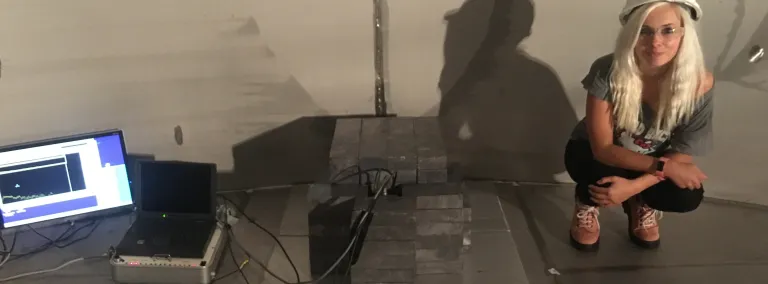LZ team installs detector in water tank
Small detector will measure the amount of radiation emanating from the rock cavern
The huge water tank that for four years housed the Large Underground Xenon (LUX) dark matter detector now stands empty. A small sign over the opening that reads, “Danger! Confined space,” bars physical entry, but a solitary note sung by Michael Gaylor, a science professor from Dakota State University, once jumped that barrier and reverberated for 35.4 seconds.
Starting this week, the tank will be filled with the sounds of collaboration members installing a small detector that will be used to measure radioactivity in the cavern. It’s all part of the plan to build and install the much larger, second-generation dark matter detector, LUX-ZEPLIN (LZ).
“We need to pin down the background event rate to better shield our experiment,” said Sally Shaw, a post doc form from the University of California, Santa Barbara (UCSB).
The detector, a 5-inch by 5-inch cylinder of sodium iodide, will be placed inside the water tank and surrounded by 8 inches of lead bricks. The crystal will be covered on all sides except one, which will be left bare to measure the gamma rays that are produced when things like thorium, uranium and potassium decay. Over the next two weeks, the team will change the position of the detector five times to determine the directionality of the gamma rays.
Scott Haselschwardt, a graduate student at UCSB, said this is especially important because there is a rhyolite intrusion that runs below the tank and up the west wall of the cavern.
“This rock is more radioactive than other types of rock, so it can create more backgrounds,” he said. This wasn’t a problem for LUX, Haselschwardt said, but it was smaller than LZ and, therefore, surrounded by more ultra-pure water.
But LZ is 10 times larger and still must fit inside the same tank, potentially exposing it to more of the radiation that naturally occurs within the rock cavern. And while this radiation is harmless to humans, it can wreak havoc on highly sensitive experiments like LZ.
“Because it is so much closer to the edges of the water tank, there was a proposal to put in extra shielding—perhaps a lead ring at the bottom of the tank to shield the experiment,” Shaw said.
Like its much smaller cousin, LZ hopes to find WIMPs, weakly interacting massive particles. Every component must be tested to ensure it is free of any backgrounds, including more than 500 photomultiplier tubes, the titanium for the cryostat and the liquid scintillator that will surround the xenon container. But if the backgrounds emanating from the walls of the cavern are too high, it won’t matter.
“The whole point is to see whether the lead needs to be used in the design of the shield,” said Umit Utku, a graduate student at University College in London. “Maybe we will realize we don’t need it.”
Shaw, who created a design for lead shielding within the tank, said it’s critical to fully understand the backgrounds now.
“If we do need extra shielding, we must adjust the plans before installation of the experiment begins,” she said.
